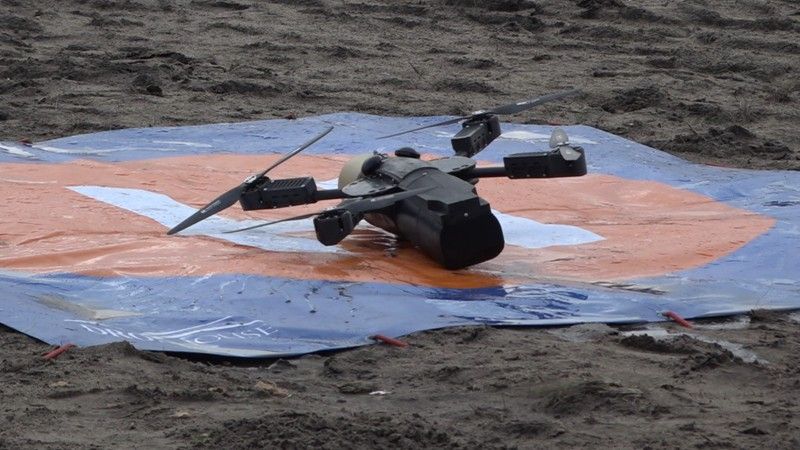- WIADOMOŚCI
Macierewicz: Thousands of UAV Systems for the Territorial Defence Component and for the Operational Units of the Polish Army
Polish Ministry of Defence is willing to purchase thousands of UAV systems for the Territorial Defence forces, as well as for the operational units – as it was stated by the Polish Minister of Defence, Antoni Macierewicz, during a special demonstration event concerning the UAV systems, held at the testing range of the Military Institute of Armament Technology in Zielonka. – We are going to acquire as many UAV systems as required, for the units of our army.This is a mass weapon, its effectiveness depends on mass use.We are speaking of thousands of examples.For both the operational units, as well as for the Territorial Defence.

The presentation which took place in field conditions, at the Military Institute of Armament Technology, was to demonstrate the capabilities offered by fusion between the modern and light warheads of high power and UAVs. Minister Macierewicz could have witnessed the Warmate loitering munitions in action. This system has been developed by the WB Electronics company. Secondly, Dragonfly VTOL UAV, developed by the Military Institute of Armament Technology, was also showcased during the event.
Light Strike Drones
Both aircraft weigh around 5 kilograms, and need a one or two-man crew. The said soldiers are able to carry several drones, along with the warheads. Warmate takes on a form of a small aircraft with pushing propeller and a warhead embedded in the front part of the fuselage. The said UAV has mission endurance of 30 minutes, at distance of 20 kilometres.
READ MORE: Warmate: Polish Loitering Munition In Use. “Two Export Agreements Have Been Signed”
Dragonfly, on the other hand, is a VTOL UAV, which, along with the warhead, is only 90 cm long, and weighs only 5 kilograms. The system may be carried by a single soldier. Once the engine booms are extended, supporting the four rotors, the UAV achieves a span of 70 centimetres. It is battery powered, has a flight endurance of 20 minutes. It may be used to attack targets at distances of up to 10 kilometres.
In case of both aircraft, the very same family of warheads has been applied, designed and manufactured by the Polish Military Institute of Armament Technology. The said warheads include GO-1 HE and GO-2HE High Explosive types, GTB-1FAE Fuel-Air Explosive, or GK-1 HEAT warhead, capable of penetrating up to 150-240 mm of armour. The aforesaid warheads package make the platform quite capable, allowing the user to act against light armoured targets, targets hidden in bunkers or fortified buildings, also making it possible to eliminate armoured vehicles or even the main battle tanks, however in the latter case, the weakest, top surface of the vehicle should be the area of aim.
Utilizing drones in urbanized areas will allow the army to carry out operations without visual contact risk, referring to the enemy. The urbanized areas constitute complicated operating environments. Combat is difficult, while striking at a specific point enhances the capacity remaining at hand. We hope that, in case of the anti-tank warheads, our designs would replace the ATGMs.
During the said demonstration, a live high explosive warhead was used, in order to showcase the Warmate’s capabilities. Col. Borkowski also announced that the Military Institute of Armament Technology is focused on developing and researching new designs. Manufacturing process takes place at a different location. In case of the warheads, a non-exclusive license, with the non-exclusivity emphasized by Borkowski, was sold to the Bydgoszcz-based Belma company, which has undertaken works to start mass production.
Łoś – Carrier for Precision Guided Munitions
The largest UAV presented in Zielonka was the Łoś [Moose] tactical UAV developed by the WB Electronics company. The said UAV, during the presentation, was armed with two dummy LARUS guided bomb units, developed by the Military Institute of Armament Technology. LARUS bombs, fitted with a guidance system and warheads which are an ordnance package derived from the Warmate and Dragonfly systems, make it possible to carry out precision strikes against optically detected threats. The bomb, which weighs 5 kilograms, may be fitted with a HE or a tandem anti-tank warhead.
READ MORE: Tactical Łoś UAV Designed by WB Group. Armament Carrying Capability

Łoś UAV is capable of carrying more than two bombs of this type. Its usable payload is 55 kilograms, however, optronic system is also contained within the said weight. Łoś tactical UAV has own weight of 85 kilograms, it is 3.1 meters long, while its wingspan is 6.4 meters. The drone takes off autonomously, from a mobile ramp fitted with a catapult. The said catapult trailer may be towed by the vehicle within which the operator station is placed. The UAV in question has been fitted with two internal combustion engines, which is an atypical solution, however, the ability to fly, should one engine fail, increases the level of safety and reliability.
Thousands of UAV systems for the Polish Army?
Summing the showcased capabilities up, the head of the Polish Ministry of Defence, Antoni Macierewicz, stressed the fact that the presented solutions are of Polish origin, and that they should enter mass production. A wide application of UAV systems is to make it possible to provide the units with effective means of defence in any conditions.
We hope that they will soon enter series production. Starting from the largest Łoś UAV, which is to have combat capability thanks to the ordnance it carries under the wings, finishing with the smallest UAVs which are to be operated in the urban areas. The operational capabilities are huge. Effectiveness, as the demonstration suggests, too. (...) Mass production of drones will allow us to drop the price. However, this is a matter of a year, at least. We need time to finalize the preparations and implement the mass production.
The Defence Minister referred to the initiative of procurement of a significant number of the attack UAV systems in this way. This type of UAVs is not contained within any list of programmes encompassed in the Technical Modernization Plan (the strike capabilities are ascribed only to the MALE and to the medium range “Gryf” UAVs, capable of carrying the armament). On the other hand, back in July, the Polish Ministry of Defence announced that short range tactical UAV (“Orlik” programme) and mini UAV (“Wizjer” programme) procurement initiatives were cancelled. These procedures are expected to be restarted, however, according to the declarations made by the Ministry, solely companies that are controlled by the Treasury may be accepted as partakers of the reinitiated tenders.
On the other hand, this year, feasibility studies shall end, which is going to lead to conclusions of contracts and initiation of deliveries of the “Mikro” VTOL mini-UAVs in 2017, and larger “Ważka” systems, a year later. Both types are destined to be operated, above all, in the urbanized areas. Probably, within the framework of the said programmes, strike capabilities will be considered too, nonetheless this is not a plausible scenario. It cannot be ruled out that attack capacities will be obtained and acquired within the framework of completely separate decisions and programmes, than the ones that had been announced earlier, or within the framework of changes in the existing programmes.















